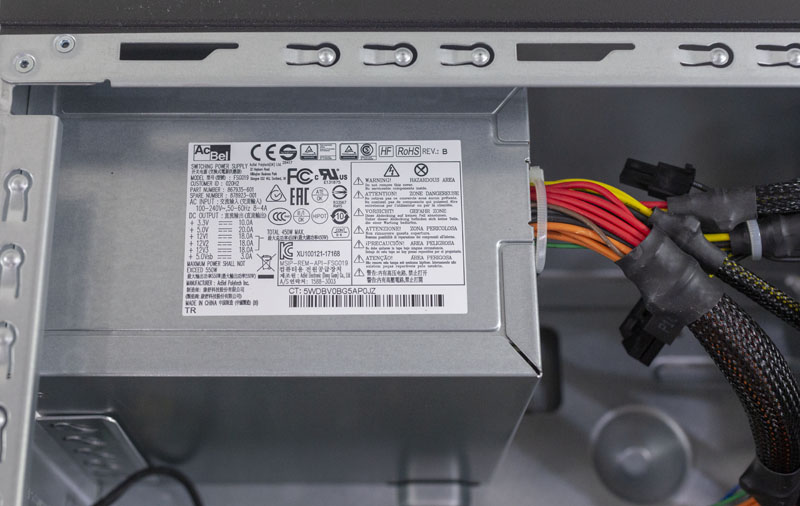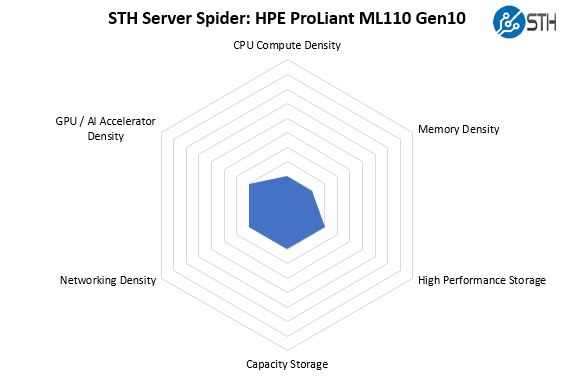HPE ProLiant ML110 Gen10 Power Consumption
Our HPE ProLiant ML110 Gen10 test server, unlike higher-end servers, does not have a power supply capable of reading power consumption. Instead, we hooked this up to our lab power meters and took a few power readings at 120V using our Extech 380803 True RMS power analyzers.
- Idle: 45W
- STH 70% Load: 76W
- 100% Load: 92W
- Maximum Recorded: 97W
Often these servers will sit at idle for long periods of time. If you are sizing servers for web hosting style deployments, servers typically sit on the lower end of the spectrum, closer to the idle numbers versus the STH 70% load figures.
We wanted to take a moment to discuss the power supply in our unit. HPE supplied a 550W power supply which is simply awesome. As you can see from our testing, we were nowhere near 550W of power consumption in our tests.

The actual efficiency of this power supply seems to be fairly good, but we would like to see a formal 80Plus rating on the units going forward to help server buyers compare. This is an area where the industry has standards, and we would like to see HPE provide rating information aligning to these standards.
HPE ProLiant ML110 Gen10 Noise
One area that we do not comment on normally with servers, but will in this case since it is a tower server designed for office use, is that this server, including the power supply, is quiet. Aside from startup, we never saw over 30dba from the unit using the Intel Xeon Silver 4108 CPU configuration. From a practical standpoint, that means that if you are more than 1 meter from the server it is going to be nearly silent and acceptable to put into a workplace or even a home office. Great job to the HPE engineering team recognizing the operating environment of the HPE ProLiant ML110 Gen10 and designing airflow and cooling throughout to be nearly silent.
STH Server Spider: HPE ProLiant ML110 Gen10
In the second half of 2018, we introduced the STH Server Spider as a quick reference to where a server system’s aptitude lies. Our goal is to start giving a quick visual depiction of the types of parameters that a server is targeted at.

This is far from the densest server. It is not meant to be. Nor is it meant to be the most powerful, nor fastest server. Instead, we see the HPE ProLiant ML110 Gen10 as an excellent server for a branch office or retail location. As such, it does a great job for this workload profile.
Final Words
Putting the HPE ProLiant ML110 Gen10 in context, it is an excellent low cost, quiet, and low power tower server. HPE’s product team did a great job of both checking all of the functionality boxes while maintaining a competitive price. For HPE shops that are looking to extend a common management framework to edge locations like offices, retail locations, and factory floors, the HPE ProLiant ML110 Gen10 will be a seamless addition. We also think that this server provides a compelling upgrade option over the HPE ProLiant MicroServer Gen10 for those edge applications that can handle a much larger chassis and higher power consumption.
There are a few items we would like to see HPE address in the future. A low-cost iKVM iLO upgrade would turn this into the Death Star platform to white box competition in this market. HPE already has competitively priced options and a top-notch design. Adding iKVM as a low/no cost upgrade would be a game-changer in the market. Other minor points of improvement are the front bezel latching mechanism and getting an 80Plus rating on the power supply.
HPE ProLiant ML110 Gen10 completely surprised us. We were not expecting to like the platform as much as we did. It does a great job of positioning itself between lower-end platforms like the HPE ProLiant ML30 Gen10 and higher-end servers like the HPE ProLiant ML350 Gen10. As such, we can unequivocally recommend the ML110 Gen10 as the “just right” server option between those two family members.




don’t want to jump too far ahead and spoil it – haven’t read this yet – but i wonder if it’ll be a 9.3, 9.4, 9.5 or *gasp* a 9.6?!?!?!?!
Honestly I do not understand whole this Bronze/Silver business. Single E-21xx can kill that price/performance/energy-consumption wise. So the only advantage of Bronze/Silver is RDIMM support and up to 768GB RAM. But with today’s prices who would buy this CPU with more than 64GB RAM and 64GB is still supported by E-21xx.
Really thorough review. Good job STH.
KarelG I looked at the specs it only supports 192GB according to HPE since there’s 6 DIMM slots.
Thank god you’re doing real reviews of servers. I hate the garbage pieces by itpro UK where they don’t even seem to review servers nor know why a server is like it is. Do more of these so I can write off itpro as vendor sponsored junk that it is.
I just sent this review to our procurement people for a pre BF buy. Timely.
Or you buy this and upgrade to a Xeon Gold for less than HPE charges… Smart Buy is the bomb tho. We use it all the time.
You didn’t mention this but HPE uses Torx screws everywhere. They suck and they’re difference sizes.
Well doe and thorough review
Thank you for the thorough review Patrick.
I had an unfortunate discovery on a Gen 9 ML350 with iLO4 and I am wondering if the same apparent weakness exists in the Gen 10/iLO5. The iLO on my server suffered a hardware failure. The BIOS then indicated it was preventing the OS from loading. In an attempt to work around it and get our server running, I tried to disable the iLO. Surely, my thinking went, since a BMC should just be for monitoring/management this should be possible, but nope, HPE made the iLO part of the BIOS dependency chain (this was an “upgrade”, in effect as of a certain firmware version, so apparently it’s not how the server was shipped).
Here’s the the note about inability to disable iLO in Gen9: https://support.hpe.com/hpsc/doc/public/display?docId=emr_na-a00018423en_us
Note that HPE support did promptly replace the motherboard in our server to address the issue, so the overall warranty/support experience was positive.
This exposed what seems a very poor design choice to me – essentially turning a positive feature/reliability improvement (BMC) into a potential liability. So I am curious if the Gen 10/iLO5 has the same design.
Also worth noting/remembering that HPE keeps BIOS updates behind a paywall (you have to have an active warranty/support contract). To me this limits resale value/ability to use these in a non-critical workloads (areas where it may otherwise be fine to not have a warranty but where you still want BIOS updates for security, reliability or other reasons). Dell and Supermicro do not do this (in my limited experience). So, depending on your use case, this may effectively reduce the value of any HPE server.
Ya’ll do awesome reviews. We’re fixin to get a few of these.
@Ryan, that does seem like an odd choice since OOB management can be an attack surface that some organizations choose to do without altogether. I know one could just leave the NIC unattached, but some vendors allow the option to expose OOB via the normal ethernet interfaces, so someone with root access could still hijack it…
There is a lot of talk about the iLO Advanced license, but no price is mentioned, or did I miss it?
WRONG for a small business! You can not buy the caddies for drives…you can only buy super expensive drives from HPE!!!!!
Patrick in your review of the MSG10+ you tested compatibility with various server OS including Proxmox. Can you speak to the compatibility of running Proxmox on the ML110 G10? I’ve seen some posts talking about issues installing Proxmox on prior versions of the ML110. Thanks.
Does this power measurements were made with all 8 HDDs installed in server? Because those are taking most of the power.
@Arvis – You can but drive caddies from third party manufactures on ebay – this is where I purchased mine.